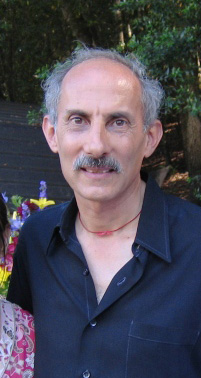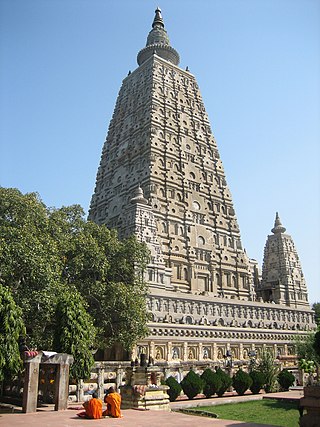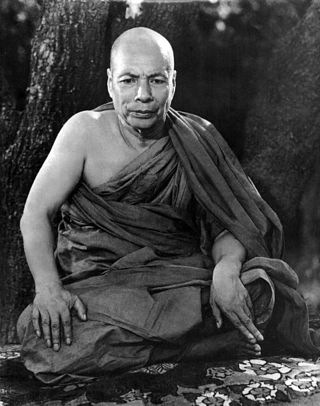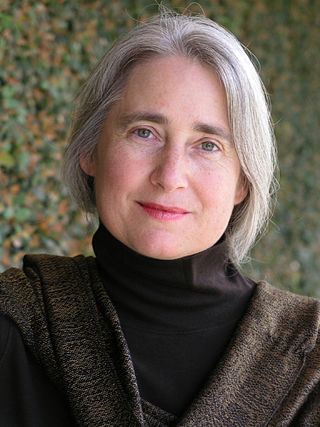
Mahāsī Sayādaw U Sobhana was a Burmese Theravada Buddhist monk and meditation master who had a significant impact on the teaching of vipassanā (insight) meditation in the West and throughout Asia.

The term American Buddhism can be used to describe all Buddhist groups within the United States, including Asian-American Buddhists born into the faith, who comprise the largest percentage of Buddhists in the country.

Satya Narayana Goenka was an Indian teacher of Vipassanā meditation. Born in Burma to an Indian business family, he moved to India in 1969 and started teaching meditation. His teaching emphasized that the Buddha's path to liberation was non-sectarian, universal, and scientific in character. He became an influential teacher and played an important role in establishing non-commercial Vipassana meditation centers globally. He was awarded the Padma Bhushan by the Government of India in 2012, an award given for distinguished service of high order.

Buddhist meditation is the practice of meditation in Buddhism. The closest words for meditation in the classical languages of Buddhism are bhāvanā and jhāna/dhyāna.
A Jewish Buddhist is a person with a Jewish background who believes in the tenets of a form of Buddhism.
The Vipassanā movement, also called the Insight Meditation Movement and American Vipassana movement, refers to a branch of modern Burmese Theravāda Buddhism that promotes "bare insight" (sukha-Vipassana) to attain stream entry and preserve the Buddhist teachings, which gained widespread popularity since the 1950s, and to its western derivatives which have been popularised since the 1970s, giving rise to the more dhyana-oriented mindfulness movement.

Nani Bala Barua, better known as Dipa Ma, was an Indian meditation teacher of Theravada Buddhism and was of Barua descent. She was a prominent Buddhist master in Asia and also taught in the United States where she influenced the American branch of the Vipassana movement.

Jack Kornfield is an American writer and teacher in the Vipassana movement in American Theravada Buddhism. He trained as a Buddhist monk in Thailand, Burma and India, first as a student of the Thai forest master Ajahn Chah and Mahasi Sayadaw of Burma. He has taught mindfulness meditation worldwide since 1974. In 1975, he co-founded the Insight Meditation Society in Barre, Massachusetts, with Sharon Salzberg and Joseph Goldstein, and subsequently in 1987, Spirit Rock Meditation Center in Woodacre, California. Kornfield has worked as a peacemaker and activist, organized teacher training, and led international gatherings of Buddhist teachers including the Dalai Lama.
Ruth Denison was the first Buddhist teacher in the United States to lead an all-women's retreat for Buddhist meditation and instruction. Her center, Dhamma Dena Desert Vipassana Center is located in the Mojave Desert, in Joshua Tree, California. She was also a teacher at the Insight Meditation Society in Barre, Massachusetts. She sometimes taught at Spirit Rock Meditation Center in Woodacre, California.

Sharon Salzberg is an author and teacher of Buddhist meditation practices in the West. In 1974, she co-founded the Insight Meditation Society at Barre, Massachusetts, with Jack Kornfield and Joseph Goldstein. Her emphasis is on vipassanā (insight) and mettā (loving-kindness) methods, and has been leading meditation retreats around the world for over three decades. All of these methods have their origins in the Theravada Buddhist tradition. Her books include Lovingkindness: The Revolutionary Art of Happiness (1995), A Heart as Wide as the World (1999), Real Happiness - The Power of Meditation: A 28-Day Program (2010), which was on The New York Times Best Seller list in 2011, and the follow-up Real Happiness at Work (2013). She runs a Metta Hour podcast, and contributes monthly to a column On Being.
Gil Fronsdal is a Norwegian-born, American Buddhist teacher, writer and scholar based in Redwood City, California. He has been practicing Buddhism of the Sōtō Zen and Vipassanā sects since 1975, and is currently teaching the practice of Buddhism in the San Francisco Bay Area. Having been taught by the Vipassanā practitioner Jack Kornfield, Fronsdal is part of the Vipassanā teachers' collective at Spirit Rock Meditation Center. He was ordained as a Sōtō Zen priest at the San Francisco Zen Center in 1982, and was a Theravāda monk in Burma in 1985. In 1995, he received Dharma transmission from Mel Weitsman, the abbot of the Berkeley Zen Center.

The Insight Meditation Society (IMS) is a non-profit organization for study of Buddhism located in Barre, Massachusetts. It was founded in 1975, by Sharon Salzberg, Jack Kornfield, and Joseph Goldstein and is rooted in the Theravada tradition. Its first retreat center in an old mansion in Barre, Massachusetts was opened on February 14, 1976.

In Tibetan Buddhism, the Three Jewels and Three Roots are supports in which a Buddhist takes refuge by means of a prayer or recitation at the beginning of the day or of a practice session. The Three Jewels are the first and the Three Roots are the second set of three Tibetan Buddhist refuge formulations, the Outer, Inner and Secret forms of the Three Jewels. The 'Outer' form is the 'Triple Gem', the 'Inner' is the Three Roots and the 'Secret' form is the 'Three Bodies' or trikāya of a Buddha.

Anagarika Shri Munindra, also called Munindraji by his disciples, was an Indian Vipassanā meditation teacher, who taught many notable meditation teachers including Dipa Ma, Joseph Goldstein, Sharon Salzberg, and Surya Das. Anagarika simply means a practicing Buddhist who leads a nomadic life without attachment in order to focus on the Dhamma.
The Prison Mindfulness Institute is a non-profit organization founded in 1989 with the mission of supporting prisoners and prison volunteers in transformation through meditation and contemplative spirituality in prisons. The organization provides books and resources through its "Books Behind Bars" program, publishes books on prison dharma through their Prison Dharma Press, and offers a facilitator training for prison volunteers called "Path of Freedom." The organization supports prisoners in the study and practice of contemplative traditions and mindfulness awareness practices. It is an affiliate of the Buddhist Peace Fellowship and the Zen Peacemakers.

U Vimala, commonly known as the Mogok Sayadaw, was a renowned bhikkhu and vipassanā meditation master of Theravada Buddhism.
Samatha, "calm," "serenity," "tranquility of awareness," and vipassanā, literally "special, super, seeing ", are two qualities of the mind developed in tandem in Buddhist practice.
Dharma Seed is non-profit organization "dedicated to preserving and sharing the spoken teachings of Theravada Buddhism in modern languages".

Spirit Rock Meditation Center, commonly called Spirit Rock, is a meditation center in Woodacre, California. It focuses on the teachings of the Buddha as presented in the vipassana, or Insight Meditation, tradition. It was founded in 1985 as Insight Meditation West, and is visited by an estimated 40,000 people a year. The San Francisco Chronicle has called it one of "the Bay Area's best-known centers for Buddhist meditation."

Shaila Catherine is an American Buddhist meditation teacher and author in the Theravādan tradition, known for her expertise in insight meditation (vipassanā) and jhāna practices. She has authored three books on jhāna practice and has introduced many American practitioners to this concentration practice through her writings and focused retreats.













